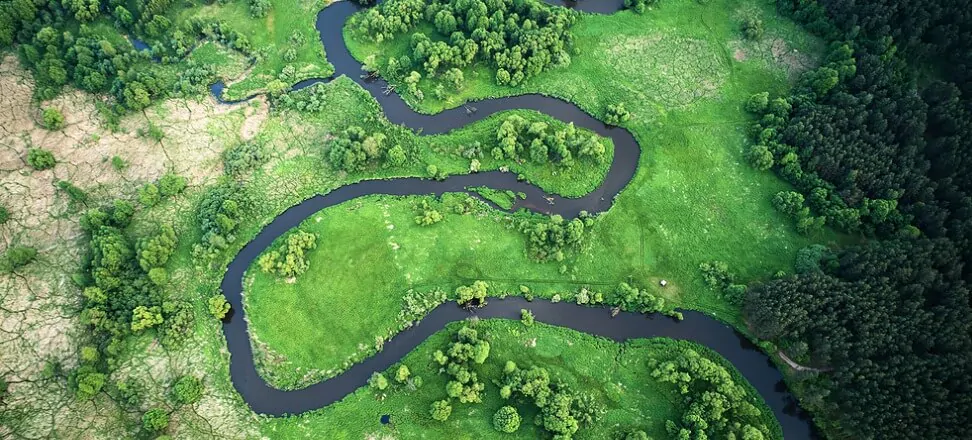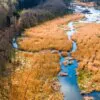News, Issue 16/2024
Are there still free-flowing rivers in Poland? Invitation to cooperate
According to the EU Biodiversity Strategy for 2030, one of the goals concerning biodiversity in aquatic ecosystems is to restore at least 25,000 km of rivers in the EU to the state of so-called free-flowing rivers by 2030. At the end of June this year, the European Commission published the Criteria for identifying free-flowing river segments under the EU Biodiversity Strategy for 2030 in English.
What is the assessment about?
The assessment applies to river segments identified as potentially meeting the criteria for free-flowing rivers. It is expected that such segments or rivers will be identified in member states by respective water administrations or indicated by non-governmental organizations operating in this field.
The methodology assumes the assessment of three out of four aspects of the river’s hydrological connectivity, namely longitudinal continuity, lateral connectivity with the riparian zone, and connectivity with groundwater. The temporal aspect of flows is not considered at this stage of the assessment.
For each of these dimensions, a number of barrier types are proposed, which should be considered in the analysis. These are physical barriers in the form of dams, weirs, etc., in the case of transverse barriers, levees, and riverbank reinforcements for longitudinal barriers, and riverbed reinforcement for the criterion of vertical connectivity. The permeability of these structures for fish species and for the sediment carried by the river is assessed, as well as their relative length in relation to the length of the assessed segment. Additionally, pressures located upstream and downstream of the assessed segment and the length of the segment meeting the expected ecological functions are evaluated.
Methodology and next steps
The next phase of work involves practically testing the developed methodology on river segments that could potentially meet the criteria for free-flowing rivers. In Poland, the evaluation team appointed by ECOSTAT is represented by Dr. Katarzyna Suska and MSc Kamila Belka from the Inland Fisheries Institute – National Research Institute (IRŚ-PIB), and the representative of ECOSTAT’s Free-Flowing Rivers (FFR) working group is Prof. Piotr Parasiewicz (IRŚ-PIB).
Across the European Union, teams and individuals are being sought to contribute to the practical evaluation of the methodology by applying it to selected river segments. The case study results will be analyzed in terms of the correctness of applying the criteria, the consistency of the assessment result with expectations, and the sensitivity of the result to changes in the criteria value ranges. The authors of the case studies will be able to submit comments on the process and their conclusions regarding the accuracy of the assessment.
Involving a large number of Polish river segments will allow for better adaptation of the assessment criteria to the morphological and ecological types of rivers in our country.
Who can participate?
Not only the country’s water and environmental administration but also practitioners and all stakeholder groups concerned with the proper assessment of river ecosystems in Poland, their restoration, and proper use are warmly invited to participate in this exercise. Research projects, social and private initiatives, NGOs, and all other organizations capable of contributing are also invited to test the methodology and submit case studies.
What should you know?
Applying the methodology requires some familiarity with spatial data available through regional and national mapping portals, as well as practical knowledge of the assessed river. Familiarity with Geographic Information Systems (GIS) software will be helpful. It may be necessary to search for data sources on existing barriers and expected fish species. Basic knowledge of ichthyofauna and hydrology will be useful for evaluating the collected information. Authors can use the Water Management Plans and the river water body characterization sheets developed for the Water Framework Directive.
How to get involved?
Case studies should be completed and submitted by November 30 of this year. An Excel template has been developed to assist with the methodology, where all calculations are made. Teams are also asked, if possible, to submit files used in the GIS program and to fill out the process evaluation form. Details are available on the European Commission website.
How to submit the results of the analyses?
The results of the river segment assessments should be sent to the email address [email protected] (Kamila Belka) with a copy to the coordinator of the ECOSTAT FFR working group, Wouter van de Bund ([email protected]). Any questions can also be directed to these addresses.









